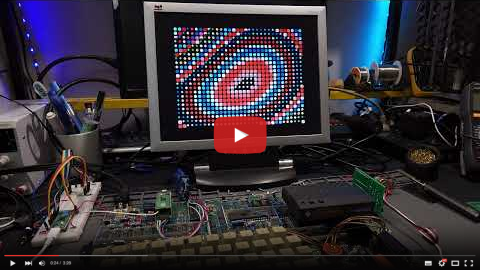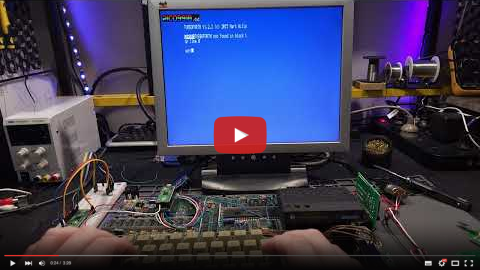PICO9918
A drop-in replacement for a classic TMS9918A VDP using a Raspberry Pi Pico.
The TMS9918A emulation is handled by my vrEmuTms9918 library which is included as a submodule here
Supported devices
This is a list of devices the PICO9918 has been tested and confirmed to work on.
- Texas Instruments TI-99/4A (NTSC and PAL)
- Texas Instruments TI-99/4QI
- Dan Werner TI-99/22
- ColecoVision (NTSC and PAL)
- Coleco ADAM (NTSC)
- MSX
- NABU Personal Computer
- Powertran Cortex
- Sega SC-3000
- Sord M5
- Tomy Pyuuta
Homebrews:
If you have tested the PICO9918 on any other device, please let me know and I'll happily update this list. :)
Unsupported devices
So far, there aren't any.
F18A compatibility
Work is being done to add F18A compatibility to the PICO9918. The video below was captured directly from the PICO9918 VGA output running various F18A demos on a TI-99/4A.
Pre-release firmware for F18A compatibility mode is available in Releases.
Purchasing options
Fully assembled and tested PICO9918 v1.0s are available on my Tindie store:
Also (more convenient for North America)
Hardware
There are two main variants of the hardware.
v1.0 (formerly v0.4)
PICO9918 v1.0 is the single board version which doesn't require a piggy-backed Pi Pico. It is in the process of being manufactured now and is based on v0.4 seen below:
Once I have tested v1.0 and made it available, I will publish the schematics and gerbers for this version.
v0.3
v0.3 schematic and gerber available now. This revision has been tested on my two TI-99/4As (PAL and NTSC) and my HBC-56 and is fully functional, however it is not representative of the final PCB design which will include the RP2040 directly on the PCB.
PCB v0.3 Notes
There are a number of 0Ohm resistors (jumpers). You may need to omit the RST resistor. On some machines, the extra time is required to bootstrap the Pico. This will be changed to a soft reset on v0.4.
Raspberry Pi Pico Module
Note: Due to GROMCLK and CPUCLK using GPIO23 and GPIO29, a genuine Raspberry Pi Pico can't be used. v0.3 of the PCB is designed for the DWEII? RP2040 USB-C module which exposes these additional GPIOs. A future pico9918 revision will do without an external RP2040 board and use the RP2040 directly.
Purchase links:
- https://www.amazon.com/RP2040-Board-Type-C-Raspberry-Micropython/dp/B0CG9BY48X
- https://www.aliexpress.com/item/1005007066733934.html
I could reduce the VGA bit depth to 9-bit or 10-bit to allow the use of a genuine Raspberry Pi Pico board, but given the longer-term plan is to use the RP2040 directly, I've decided to go this way for the prototype.
Firmware
If you're not interested in building the firmware yourself, you'll find the latest firmware in the Releases.
To install, just hold the 'BOOTSEL' (or 'BOOT') button while plugging the Pico into a PC, then drag the pico9918.uf2 file on to the new USB drive which should have the volume label RPI-RP2. The Pico will restart (and disconnect) automatically.
Development environment
To set up your development environment for the Raspberry Pi Pico, follow the Raspberry Pi C/C++ SDK Setup instructions.
Windows
For Windows users, there is a pre-packaged installer provided by the Raspberry Pi Foundation: https://github.com/raspberrypi/pico-setup-windows/releases/. Once installed, just open the pre-configured "Pico - Visual Studio Code" from your start menu.
The build system expects python3 to be available. If you have installed Python 3 outside of the Microsoft Store, you may need to alias your Python executable.
You can do this from an elevated (Administator) command prompt in your python directory e.g. C:\Program Files\Python310\ by creating a symlink with the command: mklink python3.exe python.exe.
Discussion
For all the latest news and discussion on the PICO9918, you can follow this AtariAge thread
Videos
Initial "raw" videos recorded in the moments following the first boot on my TI-99/4A.
These videos are showing the v0.2 hardware with an external Pi Pico providing the required GROMCLK signal to the TI-99. This signal has been added to v0.3. I'm still waiting on v0.3 boards to arrive.
It freaking works!
Don't mess with Texas!
80 column mode
And now v0.4 - the single board version:
v0.4 prototype working!
F18A mode development preview
Licensing
Hardware
The hardware design files in this repository are licensed under the CERN-OHL-S. See LICENSE_HARDWARE.md for details.
Firmware
The firmware code in this repository is licensed under the MIT License. See LICENSE_FIRMWARE.md for details.









